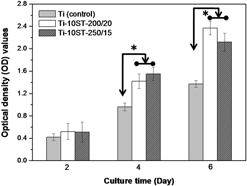Crossref Citations
This article has been cited by the following publications. This list is generated based on data provided by
Crossref.
Sahoo, Souvik
Sinha, Arijit
and
Das, Mitun
2020.
Synthesis, characterization and in vitro biocompatibility study of strontium titanate ceramic: A potential biomaterial.
Journal of the Mechanical Behavior of Biomedical Materials,
Vol. 102,
Issue. ,
p.
103494.
Sahoo, Souvik
Joshi, Anuja
Balla, Vamsi K.
Das, Mitun
and
Roy, Shibayan
2021.
Site-specific microstructure, porosity and mechanical properties of LENS™ processed Ti–6Al–4V alloy.
Materials Science and Engineering: A,
Vol. 820,
Issue. ,
p.
141494.
Yang, Dandan
Zhang, Wenxiong
Wang, Yan
Li, Lijie
Yao, Fangyi
Miao, Lei
Zhao, Weixing
Kong, Xingang
Feng, Qi
and
Hu, Dengwei
2021.
Formation mechanisms and electrical properties of perovskite mesocrystals.
Ceramics International,
Vol. 47,
Issue. 2,
p.
1479.
Sahoo, Souvik
Licata, Olivia
Mazumder, Baishakhi
and
Roy, Shibayan
2022.
Novel insights on the near atomic scale spatial distributions of substitutional alloying and interstitial impurity elements in Ti-6Al-4V alloy.
Journal of Alloys and Compounds,
Vol. 907,
Issue. ,
p.
164511.
Sahoo, Souvik
and
Roy, Shibayan
2023.
Novel insights on the grain boundary α phase microstructure formation and orientation development in Ti-6Al-4V alloy.
Journal of Alloys and Compounds,
Vol. 968,
Issue. ,
p.
172265.
Wu, Nan
Gao, Hongyu
Wang, Xu
and
Pei, Xibo
2023.
Surface Modification of Titanium Implants by Metal Ions and Nanoparticles for Biomedical Application.
ACS Biomaterials Science & Engineering,
Vol. 9,
Issue. 6,
p.
2970.
Yadav, Akhilesh Kumar
Tripathi, Himanshu
Dubey, Ashutosh Kumar
and
Rath, Chandana
2024.
In-vitro assessment of biocompatibility and antimicrobial properties of 85S bio-glass and SrTiO3 composites.
Materials Chemistry and Physics,
Vol. 320,
Issue. ,
p.
129442.
Kaczmarek-Szczepańska, Beata
Zasada, Lidia
Wekwejt, Marcin
Brzezinska, Maria Swiontek
Michno, Anna
Ronowska, Anna
Ciesielska, Magdalena
Kovtun, Ganna
and
Cuberes, M. Teresa
2024.
PVA-Based Films with Strontium Titanate Nanoparticles Dedicated to Wound Dressing Application.
Polymers,
Vol. 16,
Issue. 4,
p.
484.
Paul, Sudeep
Mondal, Sanjib
Dutta, Sutanu
Mandal, Durbadal
Bera, Supriya
and
Das, Mitun
2024.
Effect of SrTiO3 incorporation in Mg matrix: Microstructure, mechanical, corrosion and in vitro bioactivity study.
Materials Letters,
Vol. 358,
Issue. ,
p.
135826.
Sahoo, Souvik
and
Roy, Shibayan
2025.
Micro-texture formation and the interrelation with bulk texture evolution in β deformation of Ti-6Al-4V alloy.
Materials Characterization,
Vol. 220,
Issue. ,
p.
114620.
